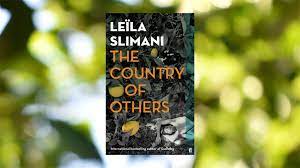 Earlier this year, I read Leila Slimani’s Lullaby, a slim novel about a nanny who murders the children under her care. It is a psychological study focusing on one woman’s breakdown and exploring what would lead her to commit such an unthinkable act.
Earlier this year, I read Leila Slimani’s Lullaby, a slim novel about a nanny who murders the children under her care. It is a psychological study focusing on one woman’s breakdown and exploring what would lead her to commit such an unthinkable act.
Slimani’s latest novel, The Country of Others, couldn’t be more different. The first part of a projected trilogy, the novel is a family saga set in colonial Morocco in the 1950s, as the struggle for independence from France intensifies. The story revolves around a French woman, Mathilde, who has fallen in love with Amine, a Moroccan soldier fighting in the colonial army during World War II. Mathilde eventually marries Amine and travels to Morocco to be with him. There she must learn to adapt to the role of women in Arab and Muslim societies– to raise the children and to be obedient to her husband. This transition is difficult for the free-spirited Mathilde. Her situation is made harder by the fact that she is a European woman married to an Arab man. She is rejected by the French colonists for marrying a “native” and never fully accepted by Arab society either. As the struggle for independence gains strength, Amine also feels caught in the middle. He served France as a soldier and is married to a French woman. However, he also keenly feels the humiliations heaped on him by the European colonists. His brother, Omar, is a nationalist and is involved in the uprising against the French.
Slimani tells the story in the third person, but primarily focusing on Mathilde’s point of view. Sections of the novel also focus on Mathilde and Amine’s daughter Aicha and on Amine’s sister Selma. Aicha is another character who reflects the family’s position as neither here nor there. Though she is nominally an Arab Muslim through her father, she attends a French school run by Catholic nuns. Throughout the novel she prays to the Virgin Mary for protection, even at the point when the French farms around her home are being attacked.
Selma is a young woman who rebels against the constraints placed on women in Arab societies. There is an important incident in the novel when Amine finds a picture in a shop window of Selma and her French lover. This incident allows Slimani to describe the Arab concept of honor and need to control women’s sexuality.
Slimani vividly captures the family’s increasing isolation from everyone around them and their resistance to being put in either of the opposing camps. For example:
All the feelings that rose inside them seemed like a form of treachery, and so they preferred to stay silent. They were at once victims and murderers, companions and enemies, two hybrid beings incapable of giving a name to their loyalties. They were excommunicated; two worshippers who could no longer pray in any church and whose god was a secret god, a private god whose name they didn’t even know ( 291-92).
Slightly later, Amine reflects on the family’s position as a hybrid while observing the lemon-orange hybrid he has planted in the yard:
Amine thought about how the fruit of the lemange tree was inedible. Its pulp was dry and its taste so bitter that it brought tears to his eyes. And the world of men is just like the world of botany, he thought. In the end one species dominates another. One day the orange will win out over the lemon, or vice versa, and the tree will once again produce fruit that people can eat (306-07).
Slimani’s writing is lyrical and the English translation by Sam Taylor (from the original French) effectively conveys that quality. I look forward to reading the rest of the trilogy when it comes out. Overall, I would highly recommend The Country of Others to those interested in family dramas and in issues of colonialism.
One thought on “Review: The Country of Others by Leila Slimani”